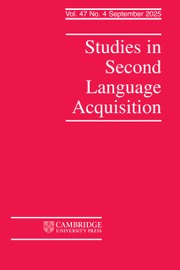No CrossRef data available.
Article contents
Structural priming facilitates L2 learning of the dative alternation in Mandarin
Published online by Cambridge University Press: 18 September 2024
Abstract
This study investigated whether structural priming, as a reflection of error-driven learning mechanisms, could facilitate second language (L2) learning of the dative alternation in Mandarin. We sought evidence of learning from both priming and acceptability judgment data. Participants were 25 native speakers and 41 classroom learners (CLs). After a priming session in which participants predicted and then saw what a virtual partner had written to describe pictures (prime trials, with only acceptable verb-dative pairings), CLs showed increased production of these acceptable pairings and increased acceptability ratings for them. The observation of such longer-term priming effects beyond the priming phase, together with an inverse frequency effect of priming observed among the CLs, aligns well with error-driven learning accounts. However, we did not find evidence for statistical preemption, in that participants did not decrease ratings for unacceptable pairings as a result of exposure to their competing alternatives.
- Type
- Research Article
- Information
- Open Practices
Open data
Open materials
- Copyright
- © The Author(s), 2024. Published by Cambridge University Press



